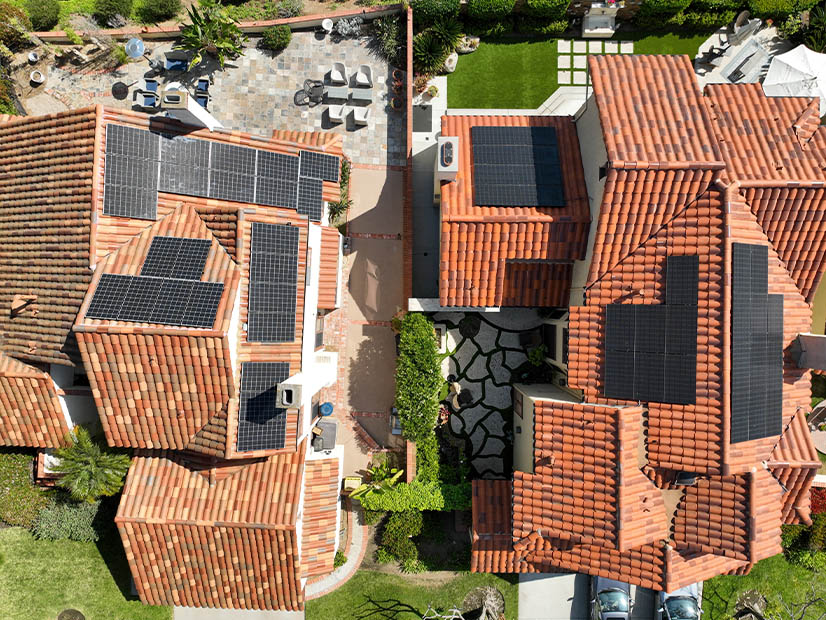
The California Public Utilities Commission received 30 sets of comments last week on possible changes to its controversial net metering plan, including an alternate way to compensate homeowners who export surplus solar power to the grid.
A CPUC administrative law judge issued the initial proposal, NEM 3.0, in December, saying the current approach, NEM 2.0, unfairly requires most utility customers to pay more for electricity to benefit those who can afford to put solar panels on their roofs.
“Our review of the current net energy metering tariff, referred to as NEM 2.0, found that the tariff negatively impacts nonparticipating customers, is not cost-effective, and disproportionately harms low-income ratepayers,” CPUC Administrative Law Judge Kelly Hymes wrote. (See California PUC Proposes New Net Metering Plan.)
After pushback from the solar industry, the CPUC put the plan on hold in January. (See CPUC Postpones Net Metering Plan.) In May, Hymes asked parties to comment on questions she posed regarding possible alternatives.
The judge’s questions focused on a “glide path” to transition rooftop solar owners from the generous benefits they now receive, and non-bypassable charges (NBCs) for solar owners based on their gross energy consumption, including use of the solar energy they generate.
The voluminous response to the judge’s questions came from industry groups and environmental advocates, among others.
The Solar Energy Industries Association (SEIA) contended that reducing solar subsidies “would place the future of the solar industry in California in jeopardy, and thereby not fulfill the Commission’s statutory obligation that customer-sited renewable distributed generation continues to grow sustainably.”
Most of the environmental groups that weighed in echoed the argument.
In their joint comments, the state’s three largest investor-owned utilities, which have pushed for net metering reform, supported the December proposed decision while urging the CPUC to “adopt a new successor tariff as expeditiously as possible.”
“Reform of the net-energy metering program is necessary to address its growing outsized subsidy and remedy the inequity between participating and non-participating customers created by the program,” Pacific Gas and Electric, Southern California Edison and San Diego Gas & Electric argued.
The utilities said $4 billion in costs would be shifted this year from ratepayers with rooftop solar to those without it. NEM 2.0’s subsidy for solar owners raised electric rates by 10-21% for other ratepayers last year and will increase their bills as much as 31% by 2030, they said.
“Each additional adoption of rooftop solar increases rates for non-participants because a smaller pool of remaining customers must pay for fixed infrastructure and policy costs, including the NEM subsidy,” the utilities said. “Without reform, this unsustainable cycle will continue ad infinitum.”
ACC Plus and NBCs
The December decision proposed reducing compensation for customers with rooftop solar from the full retail rate, which is now much higher than the cost of utility-scale solar, to an avoided-cost rate that would consider the value of behind-the-meter generation for resource adequacy and grid reliability. That could cut the reimbursement rate by more than half.
The proposed decision would charge solar owners — who currently pay only small amounts for interconnection and grid maintenance — a grid participation charge (GPC) of about $40 per month on average. The decision proposes partly offsetting the charge with a market transition credit (MTC) of up to $5.25/kW per month, depending on the utility.
It would also establish a rebate program for customers who add storage to solar under what’s colloquially called NEM 3.0, but which the CPUC calls the net billing tariff.
In her May ruling, Hymes asked commenters to address possible alternatives. In place of the MTC, she asked parties to comment on another approach called “ACC Plus,” which would pay customers an export adder on top of the avoided-cost rate. (ACC stands for avoided cost calculator.)
The utilities said they preferred the MTC plan, in part because ACC Plus would incentivize exports to the grid instead of boosting behind-the-meter storage capacity.
SEIA and others said ACC Plus would be better than MTC because it would compensate ratepayers for exporting more to the grid, similar to the current setup under NEM 2.0.
The non-bypassable charges (NBCs) based on gross consumption were proposed by the Sierra Club, the judge said. Under the proposal, homeowners would be charged for using the behind-the-meter resources they generate as well as imports from the grid. Those with rooftop solar now only pay extra charges for imports.
The utilities supported the change. “Recovering fixed policy and infrastructure costs through mechanisms such as the grid participation charge or the Sierra Club gross-consumption mechanism for recovering NBCs are not only legal, but also are required to eliminate the burden of the NEM subsidy on non-participants.”
SEIA disagreed, saying the charges would be illegal.
“The Commission should not assess NBCs on any [behind-the-meter] consumption. The energy produced and consumed [behind-the-meter] does not originate nor travel on the systems of the Commission regulated investor-owned utilities,” the trade group said.
“The Commission does not have regulatory authority over individual NEM customers as generators,” it added. “These generators are not electrical corporations (and thus public utilities) over which the Commission has broad sweeping regulatory authority. Indeed, the definition of electrical corporation specifically excludes ‘independent solar energy producers.’”
Reply comments are due by June 24, and a revised proposed decision could be issued as early as mid-July.

